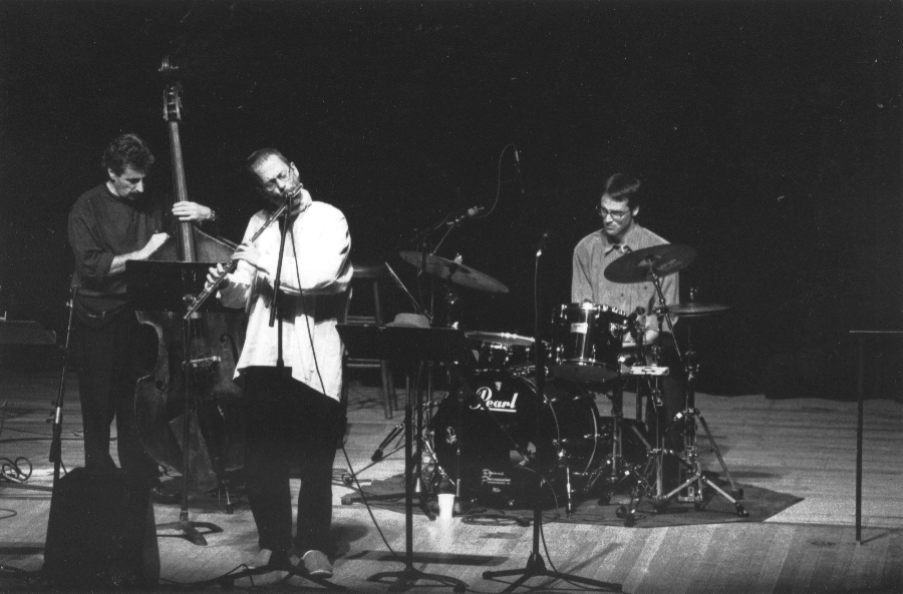In late 1989, Chapin organized the ensemble that would be his primary focus for the rest of his life.
The motivation was a request from his friend and fan Bruce Gallanter, who managed the Downtown Music Gallery at the time. "Bruce asked me to put something together for a mini-festival he was organizing at a place called the Gas Station," Chapin recalled. "I had a sextet at the time, but thought a trio would be a little different. Mario and I had already been playing together for eight years at that point, and Mario had introduced me to Pheeroan akLaff. That was the trio that played our first gig, at the Gas Station Jazz Festival in September 1989. A couple of months later, Bruce hooked me up with the Knitting Factory as an opening act for John Zorn. Steve Johns was playing his first gig with us then, and the club recorded our set and put a tune on Volume 3 of their anthology series." The date was December 26, 1989, and the composition that appeared on the A&M anthology Live at the Knitting Factory Volume 3 was "Insomnia," which Chapin would revisit when he added a brass section to the trio three years later.
To complete this felicitous conjunction of events, the Knitting Factory launched its own label within the year. "We were the third signing," Chapin recalled, "and the recording contract gave us the forum."
“Thomas worked upon applying the Law of Three to every area of his life.”
Third Force, the first album by the trio, was primarily taken from Skidmore College and Hillside performances during January 1991. The group had settled in during the previous year, videotaping a program for Spanish television and making an appearance at the JVC-Saratoga festival in addition to its several club gigs, and had quickly developed a recognizable personality that informs all of the album's music, but especially the six compositions featuring alto sax. After an opening drum invocation, the first track, "Ahab's Leg" establishes the template for many of Chapin's creations: uncommonly integral unison statements by Chapin and Pavone (with the bassist either bowing, as here, or plucking on tracks such as "Resolution 678"), pulverizing riffs and pinpoint breaks, heedless collective rushes through complex changes in time signature, and a shared sense of pacing as improvisations unwind and the sections merge into larger statements. Ornette Coleman, who Chapin cited with Kirk as a primary influence, is suggested in the loose coherence of "Ahab's" alto solo and the almost Southwestern sax tone. (The blues-ballad sections of "Resolution 678" recall another late, lamented Coleman disciple, Julius Hemphill); but Chapin's more pointed use of thematic signposts and the trio's conversational shifts in intensity had already created an identify for both leader and band.
Another notable sign in this first trio effort is the clarity that allows the band to veer on "Iddly" between hoary 2/4 jitterbug vamps and Johns' boogaloo groove. Chapin's former boss Hampton can no doubt relate to such bar-walking music, although this is music for those who choose to walk the bar's edge. Chapin also reveals his talents for dispensing choice quotes on this track, including "Boogie Stop Shuffle" by Charles Mingus (another former Hamptonian) and Lester Young's "Tickle Toe." "Tale of the Sands," the album's earliest track, is a superior forum for Chapin's ripe though not overbroad sound and for Pavone's command of the bass. With his mammoth beat and unflagging passion, Pavone ensured that the trio would be more than a leader-plus-rhythm operation. The complementary "Then" and "Now" combinine for an excellent accounting of Chapin's warmth on flute, and "Poet of Central Park" reveals a harmonic boldness recalling Eric Dolphy, a hum-and-play technique derived from Roland Kirk, and more eloquent bass playing and perfectly calibrated ensemble resolutions.
In its title piece and "Boy on a Dolphin," Third Force also acknowledges Chapin's spiritual mentor, Gil Barretto. A brief note in the CD booklet states that "The inner calling acts as third force, making the art into the vehicle of transcendence." Barretto elaborated at the memorial service held a year after Chapin's passing, saying in part that "Thomas worked upon applying the Law of Three to every area of his life. This principle suggests that for anything to occur, three forces are necessary. First there must exist an Active force and a Passive force. The friction between these two polarities, these opposing principles, must be neutralized by a Third force in order to bring about a happening..." The artistry that was Chapin's third force is manifested in the controlled evolution of the title track and the way he rides the seismic current provided by Pavone and Johns on "Boy on a Dolphin," the composition that ultimately leads to the striding erruptions of Pavone's "Stairs."
by Bob Blumenthal, jazz writer-critic, The Boston Globe
